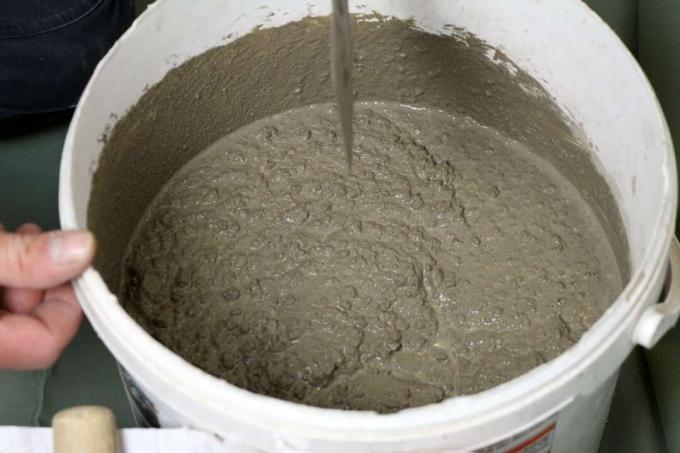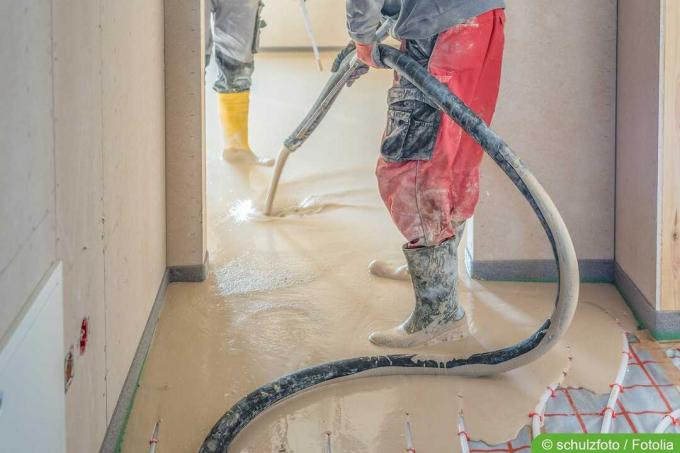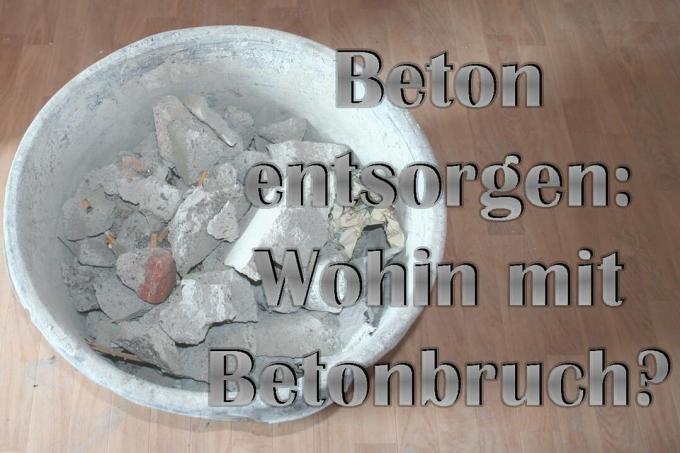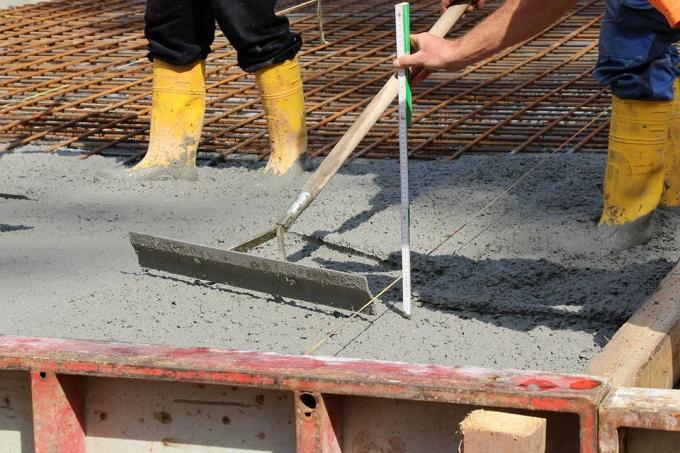

Table of contents
- Different types of concrete
- ready-mixed concrete
- fresh concrete
- precast concrete
- Prices per cubic meter
- compressive strength
- Quantity calculator for ready-mixed concrete
- Pricing Factors
Whether building roads, bridges or tunnels - concrete is a building material that can be used in many different ways and is also used in your own garden. Do-it-yourselfers often ask themselves the question of costs.
Different types of concrete
The product can be manufactured in different ways. Depending on the building materials used, there are different properties of the end product and thus advantages and disadvantages. It therefore makes sense to discuss before breaking ground which type is suitable for your own building project. Basically, a distinction is made between ready-mixed concrete, fresh concrete and ready-mixed concrete.
In addition to the classic types of concrete, there are more exotic variants depending on the building project, which have optimal properties for the corresponding building project. A distinction is made between the following types:
- fiber concrete: Also contains plastic, textile, glass or steel fibers for defined properties
- lightweight concrete: Particularly light weight due to air pockets
- heavy concrete: High weight thanks to heavy aggregate
- hardened concrete: Product with high strength class C55/67 – C100/115
- aerated concrete: A special manufacturing process ensures air voids in the end product
- exposed concrete: Has a special appearance due to the creative formwork skin
- Prestressed concrete: Small crack widths due to prestressed prestressing steel
- reinforced concrete: Steel inserts made of mats and wires ensure high tensile strength
ready-mixed concrete
This product arrives at a construction site fresh. The product is assembled in a concrete plant, from which a concrete loader or another suitable vehicle brings the delivery. A large part of the concrete used today is ready-mixed concrete, due to its consistently good quality and the sheer volume of ready-to-use product available for large projects, such as pouring a large slab foundation. The manufacturer himself is liable for the product.
fresh concrete

Fresh concrete is self-mixed concrete from the construction site. It contains all the usual ingredients, but often lacks additives such as those used in ready-mixed concrete or ready-mixes to improve properties. Imprecise working methods, which lead to uneven results, can be problematic during production leads and the construction project due to the different properties of the respective concrete batches endangered.
precast concrete
Basically, all concrete consists of three basic ingredients: water, cement and gravel. The ready-mixes in the DIY store are composed according to the exact manufacturer's recipe and promise consistent quality. Such a product is available in hardware stores as a dry product in a sack and consists of the following components:
- cement
- aggregate
- Concrete admixtures (sealant and stabilizer)
- Concrete additives (colour pigments, steel fibres, synthetic resin, fly ash, silicate dust, tuff)
- Water
Tip:
Ready mixes are of absolutely perfect quality. The manufacturer's instructions regarding the addition of water must be strictly observed, as this is the only way to guarantee the stability and quality of the end product.
Prices per cubic meter
Of course, there are major cost differences between the individual types of concrete. Which product is most worthwhile ultimately depends on the extent of the construction project. Ready-mixed concrete is the ideal solution for larger construction projects, not only in terms of costs, but also from a technical point of view. A continuous concreting of large floor slabs or foundations can only be realized with difficulty by self-manufacturing. Mixing ready-made mixtures is only worthwhile for small building projects.
The higher the quality of the product, the more versatile the fields of application. The price results from the factors and individual wishes. On average, however, the mixtures are available quite cheaply in hardware stores. The sacks, usually with a content of 25 kilograms, make their way over the sales counter. Smaller units are available in hardware stores for little money:
- craft concrete: 13 euros for 3.5 kilograms
- kneaded concrete: 10 euros for 2.5 kilograms
- concrete screed: 7 euros for 25 kilograms
- horticultural concrete: 6 euros for 25 kilograms
- foundation concrete: 3 euros for 25 kilograms
compressive strength
It is common in many places to indicate the price based on a cubic meter. Such a price indication is usually given at the same time as the compressive strength. On average, the prices for ready mixes with the respective compressive strengths are as follows:
- C40/50: 105 € / m³
- C35/45: 95 € / m³
- C30/37: 87 € / m³
- C16/20/25: 77 € / m³
- C12/15: 71 € / m³
- C8/10: 66 € / m³
Quantity calculator for ready-mixed concrete
Some manufacturers indicate on the bags exactly how much of the product is needed to fill a cubic metre. But even without manufacturer information, it is not difficult to calculate the requirement. On average, concrete has a density of around 2.5 kilograms per cubic decimeter. Accordingly, a quantity of around 2,500 kilograms of concrete is required for one cubic meter.

rule of thumb:
A sack with a standard weight of 25 kilograms yields about 10 liters of a ready-to-use mix.
It takes 1,000 liters to fill a hole the size of one cubic meter. This results in a consumption of 100 sacks of ready-mix, each resulting in 10 liters of ready-to-fill mass. Since the various products from the respective manufacturers differ in their composition, this is only a rough calculation example. The exact amount of product required can only be calculated based on the exact properties of the respective products.
Pricing Factors
Ready-mixes are available in numerous versions in hardware stores and thus cover a wide range of applications. The additives contained are reflected in the price and cause different price surcharges:
- degree of pumpability: + approx. 10 € / m³
- surcharge for antifreeze: + approx. 5 € / m³
- adding flow agent: + approx. 5 € / m³
- admixture of air entraining agent: + approx. 5 € / m³
- variety of consistency: + approx. 10 € / m³
- compressive strength of the building material: see above
- tyingretarder: + approx. 5 € / m³
- accelerator for binding: + approx. 30 € / m³
 Home editorial office
Home editorial office
Learn more about concrete, screed and cement

Fresh screed: when can it be walked on?
Screed is the basis for many floor coverings. It is durable and easy to care for. However, if the load is applied too quickly after application, it can be damaged, with costly consequences. We show how long the drying time is.

What is fiber concrete? | Features & Best Practices
What is fiber concrete? This term describes special concretes that are mixed with different fibers. They expand the possible uses in many ways and have an effective effect on the stability and durability of the concrete.

What is trass cement? | The differences to cement
Trass cement describes a special type of cement with corresponding amounts of trass. The additive makes the mortar mixed from it more resistant and is effectively suitable for certain areas of application. In this guide you will find out how the mixture differs from conventional cement mixtures.

What is flow concrete | Properties & Applications
As the name suggests, flowable concrete is a much more fluid mass than conventional concrete. This is made possible by adding a flow agent. You can find out about the properties and areas of application of concrete in this guide.

Disposing of concrete: what to do with broken concrete?
Broken concrete often occurs during conversion or demolition work. It is clear that the chunks do not belong in the normal household waste. However, this raises the question of whether concrete is building rubble, construction waste or even hazardous waste.

Drying time of foundations: how long does concrete dry?
The drying time of foundations is surprisingly long. Unlike with thin layers of concrete, the moisture can only escape from the large masses very slowly. But how long does the concrete dry and when can it be loaded?
